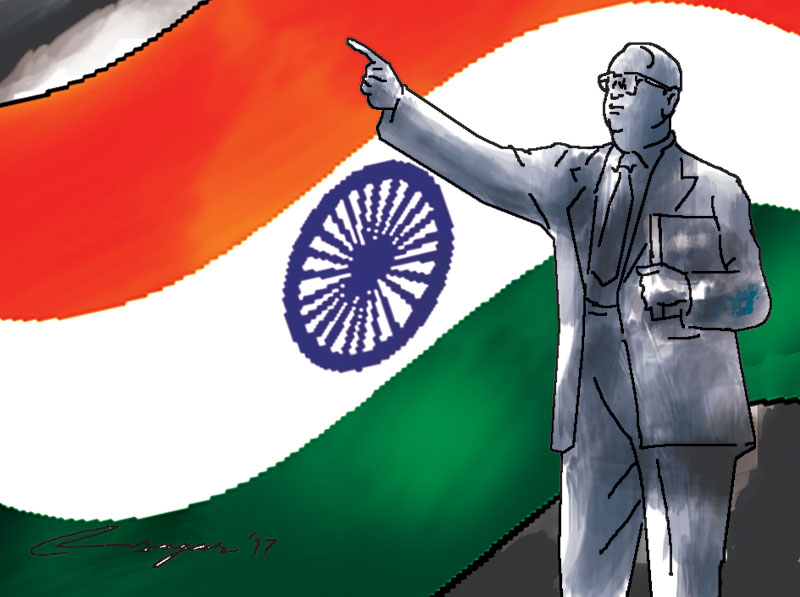Bhimrao Ambedkar: Life and times
In spite of being a statesman and a mass leader, Ambedkar always remained a reflective thinker and erudite scholar. He was also a prolific writer. No other mass leader in India has produced anywhere close to the voluminous writings that he did
Bharat Ratna Dr Bhimrao Ramji Ambedkar, reverentially called Babasaheb Ambedkar by his followers, was undoubtedly one of the most illustrious sons of India. He entered the socio-political scene in the early 1920s and played a crucial role in the social, cultural, economic and political transformation of India during the closing decades of the British Rule. After India became independent from the British Rule in 1947, Ambedkar was responsible for creating the Constitution for free India. Ambedkar was a great social reformer, a valiant champion of human rights and an emancipator of the downtrodden masses of India, who dedicated all his life to awaken the social conscience of modern India.
Ambedkar’s life is an incredible saga: born an untouchable boy, humiliated every step of the way from the childhood to youth, who went on to be at almost impossible odds to secure the highest and most reputable degrees from world class universities – MA and PhD from Columbia University, USA, and DSc from the London School of Economics besides Bar-at- Law degree from London. He then returned to India and devoted his life to the destruction of the caste-ridden old order, characterised by injustice and denial of human rights. Without being favoured either by family fortune or political lineage, but by the sheer grit of his will and backbreaking hard work, supreme courage and selfless sacrifice, he overcame bitter political opposition and perils of caste discrimination to become the principal architect of the Constitution of Independent India. He then proceeded to build the safeguards of affirmative action for establishing a more equitable society that is capable of delivering social justice to millions of downtrodden, thus heralding in India a new age of social equality and rationalism.
Most statues of Dr Ambedkar in the country depict a stocky man, invariably dressed in a blue suit and red tie, holding a book under his arm which, of course, represents the Constitution of India. Such statues can be found everywhere in India, in villages and in cities, usually at crossroads. Every year, on December 6 (the death anniversary of Ambedkar), around two million Ambedkarites throng Chaitya Bhoomi in Mumbai to pay homage to the hero they worship as their saviour. It is also not surprising that Ambedkar was voted, in August 2012, as the “Greatest Indian after Gandhi” in an e-poll initiated by some TV channels with an overwhelming majority.
In the light of these facts, it is grossly unfair to characterise Ambedkar simply as a leader of the Untouchables or Dalits as is often done even in otherwise responsible quarters. Ambedkar was not simply a leader of Untouchables, not even only a leader of the oppressed people of India. He was a national leader. His erudition, his mass movements and his role in the government and outside clearly show that he was a patriot of a sterling order.
In the course of his most eventful life, Ambedkar made outstanding contributions as a scholar, educationist, journalist, as an authority on Comparative Religion, as a policy-maker and administrator, and as a parliamentarian, besides being a jurist who became the principal architect of the Indian Constitution.
In spite of being a statesman and a mass leader, Ambedkar always remained a reflective thinker and erudite scholar. He was also a prolific writer. Perhaps no other mass leader in India has produced anywhere close to the voluminous writings that he did.
The range in Ambedkar’s works is also equally amazing. On politics: 11 books and monographs including treatises such as Pakistan or the Partition of India (1940), What Gandhi and Congress Have Done To Untouchables (1945); the classics such as Federation versus Freedom (1939), Ranade, Gandhi and Jinnah (1943); States and Minorities (1947) and Thoughts on Linguistic States (1955); on economics two pathbreaking treatises – The Evolution of Provincial Finance in British India (1917) and The Problem of The Rupee: Its Origin and Its Solution (1925); on sociology – a timeless contribution such as Annihilation of Caste (1936) besides a remarkable essay on Castes in India: Their Genesis, Mechanism and Development (1918); on anthropology – two provocatively original treatises – Who Were the Shudras (1946) and The Untouchables: Who Were They and Why They Became Untouchables (1948) and finally on religion – Magnum Opus: Buddha and His Dhamma.
Ambedkar also delivered a very large number of speeches – 537 speeches, to be precise, on a wide range of subjects and at diverse regional, national and international fora. Among the subjects, the speeches ranged from social, economic and religious issues to those relating to law and Constitution, besides political. The forums included the Bombay Province Legislative Council, (and later) Bombay Legislative Assembly, Round Table Conferences hosted by the British government in London in the role as a Labour Member of Viceroy’s Executive Council, Central Legislative Assembly (as the first Law Minister of Independent India), Constituent Assembly (as the Chairman, Drafting Committee for the Constitution of India) and the Parliament (Opposition Member, Rajya Sabha). In addition, Ambedkar gave a large number of public addresses as the most prominent leader of the social and political movement inspired by him.






